Disclaimer: Vevor sent this product to us for free for a review. That does not affect our opinion about the product. In this article, we list both what we like and dislike. Read more about this here.
What is a Portable (All-in-One) Diesel Heater?
Diesel air heaters are taking off in the van and RV world.
These heaters are quieter and use a lot less electricity than the traditional propane furnaces that are installed in most RVs and even some vans.
Related Product: Vevor also makes portable inverters, you can find our review of the 2500W model here
Permanently installed diesel heaters require a lot of installation and some knowledge about fuel lines and exhaust pipes.
They also require you to tap into the fuel tank of your van or RV (if it’s a diesel) or you will need to install one yourself.
This version of a portable diesel heater, also called an all-in-one diesel heater, has everything you need packed into one small metal box.
You only need to figure out the 12-volt power source.
The pro to an all-in-one diesel heater is you can use it to heat more than one thing.
For instance, you can heat your RV when camping or transfer it to a garage or shop during the winter.
See Also: 6 Best Diesel Heaters For Campers, RVs & Vans
Portable diesel heaters are also great for heating tents and ice fishing huts.
One thing to note is they have an exhaust system.
It will need to be placed outside or installed somewhere you can run an exhaust pipe out of safely.
Also, most people call diesel heaters that aren’t from the German brands Webasto or Eberspacher, “Chinese diesel heaters.”
I mention this because if you want to find more information about diesel heaters like the Vevor, you want to look up “Chinese diesel heaters.”
See Also: Portable Diesel Heater RV Storage Compartment Install
Vevor Diesel Heater (All-in-One 8KW Version)
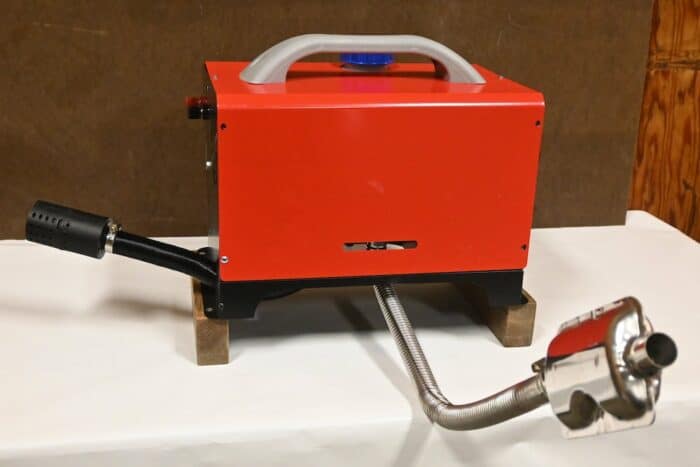
I was really excited to test out the Vevor diesel heater.
I’d heard so much about how great diesel air heaters are for boondockers who don’t have enough battery power to keep an RV furnace running all night.
It sounded like the perfect RV heater for me, so I was really happy to get my hands on one.
My experience with the shipping and parts on arrival was great.
I know they can sometimes ship these types of products with missing parts or get damaged on the way.
But for me, everything came undamaged and all the parts were there.
I choose to get the short and wide version that has the fuel tank to the side of the heating unit instead of the tall skinny kind that has the fuel tank on top.
See Also: Best Small Portable Propane Heater For Indoor & RV Use
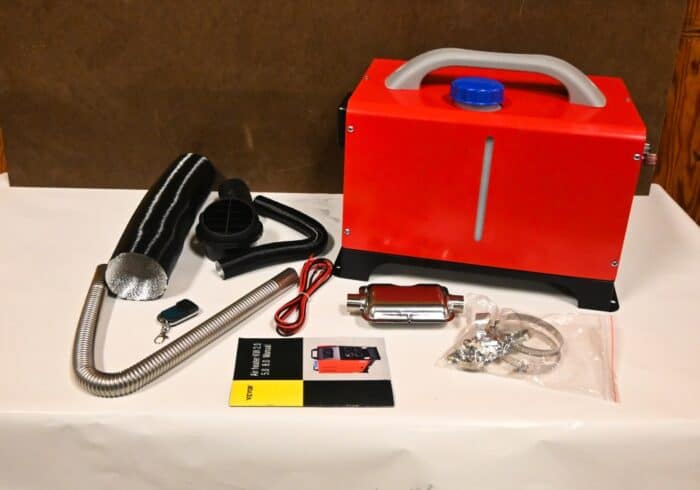
I’m planning on using this diesel heater in the storage unit of my motorhome and under a travel trailer. So short and stable was better for my needs.
I’m also not a huge fan of the fuel tank being above the heater because of possible leaks.
When the tank is on the side, my thinking is that it could be a little safer.
I’ve never heard of anyone having issues with the fuel tank on top versions though.
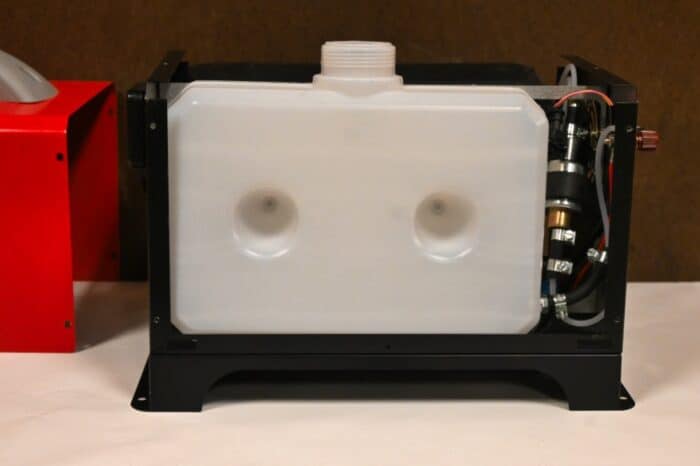
I recommend opening up any brand of portable diesel heater to make sure all the fuel tubes and wires have been installed correctly.
Another reason to open them up to see what’s inside is to make sure you know where all the main parts are.
See Also: How To Install Solar Panel On RV Roof & Connect To Battery
I initially thought there was no fuse, so I bought an inline fuse to add to the positive electrical wire.
When I started looking inside the unit more carefully, I noticed that there actually was a 20 amp inline fuse.
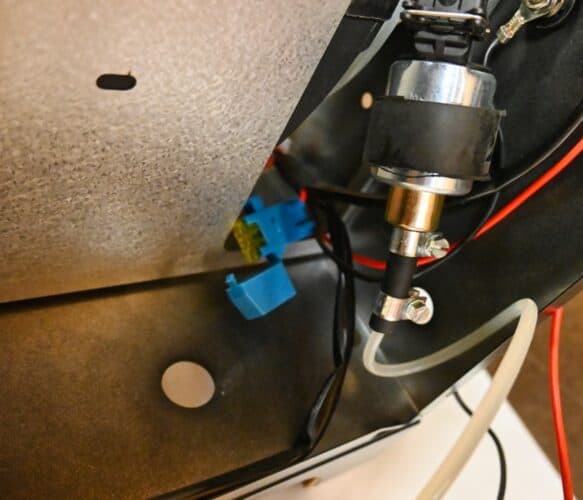
I’m glad I found it because now I will know what to check if there’s ever a time when the diesel heater won’t turn on.
The version I got has the highest heating power of 8KW. There’s also a less powerful 5KW option.
The unit size will be almost the same as the 8KW version since the fuel tanks are the same size on both.
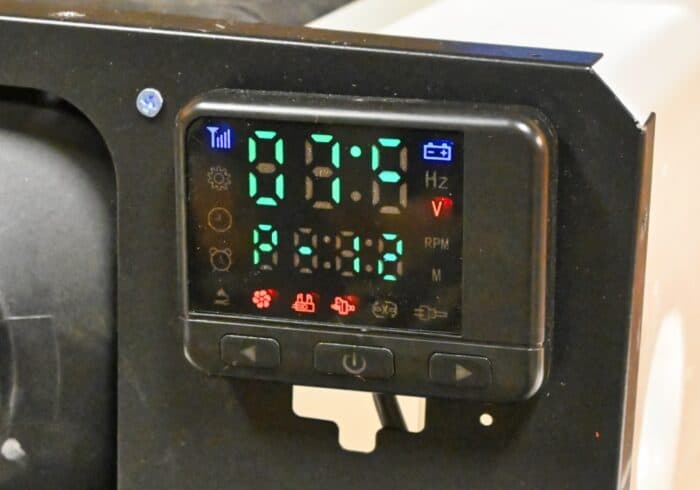
The LCD screen on this unit is one of the more simple versions. It uses only 3 buttons and it can be pretty difficult to understand.
The left button is what they call the “up” button in the manual. This was confusing to me at first because I expected it to be on the right.
You shouldn’t have to worry about most of the settings and things you can change.
See Also: RecPro & Facon RV Tank Heat Pads Power Usage & Battery Draw
All you really need to know is the screen will only display temperature in Celsius, the P-12 means the battery voltage, and you just press the arrow buttons to turn the heat up or down when the unit is running.
The heat setting is displayed as H – 1 to 6.
You can swap between the battery voltage, current temp of the heat being output, and heat setting by pressing the power button.
Setting it up to use as a portable unit that would be placed outside a tent or garage was fairly simple.
But the installation in the motorhome storage compartment was a little tricky because I needed to find somewhere for the exhaust to leave the RV.
I cover that installation more fully in this post here.
Overall, I’ve been impressed with this diesel heater and it’s keeping me warm in my RV in freezing temperatures as I write this.
Vevor Diesel Heater 8KW Features
- 8KW Heating Power
- 0.1-0.48 Diesel Consumption
- 3 Button LCD Screen
- Remote Control
- 20 lbs Dry Weight
- 15″ x 11″ x 12.6″ (LxWxH)
- 5L (1.3 Gallon) Fuel Tank
- 6 Heat Level Settings
- Quiet
- Low Power Usage (up to 40 watts when running/quick 150 surge watts for startup)
- 12 volt
- Inline 20 Amp Fuse
Included Parts
- All-In-One Diesel Heater
- User Manual
- Muffler
- 1″ Exhaust Pipe (24 inches long)
- 1″ Air Intake Pipe
- 3″ Air Duct
- 12 Gauge Wire (around 2 feet)
- Pipe Clamps
- Remote Control
Initial Setup
No portable all-in-one diesel heater is ready to go right out of the box. You need to be prepared to put some parts together.
One thing I’ve seen with every single one of these is they need to have a base added to them so the exhaust pipe can fit underneath the unit.
There are holes in the unit’s feet so you can easily screw or bolt on some extra feet for height. I used a wood 2×4 cut into the width of the diesel heater (11 inches).
See Also: What Will The RV Battery Run?
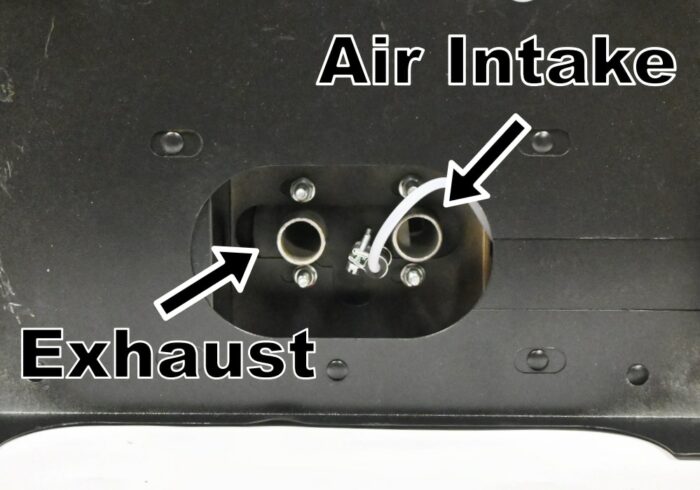
The exhaust pipe goes on the bottom hole that’s on the side that blows out the air. It’s also where the LCD screen is located.
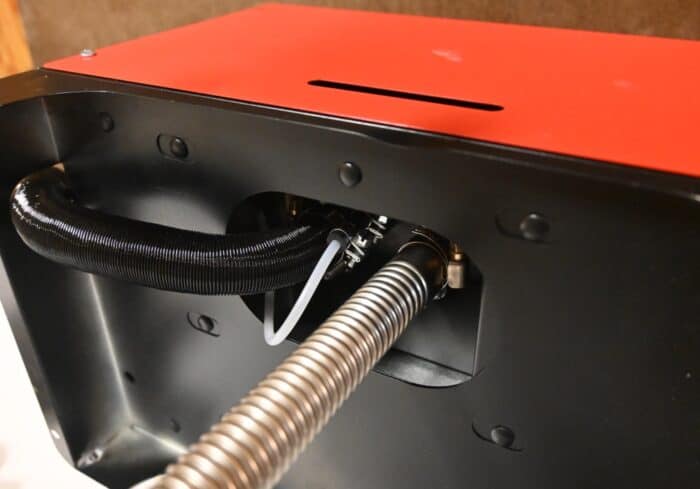
The air intake gets fed through the hole in the metal base, so it sticks out and away from the exhaust.
The exhaust pipe is a 1 inch stainless steel pipe that has some flexibility to it. If you’re careful, you can bend it close to a 90-degree angle.
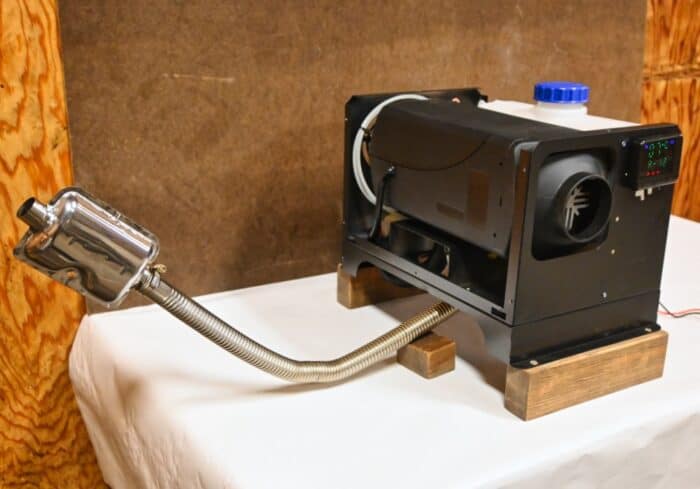
I could bend it far enough to clear the ground with the Vevor diesel heater up on a base made of 2×4 pieces.
Once the air intake and exhaust pipes are installed, all you have to do is connect a 12 volt battery.
The included wires had eyelets on one side. I installed eyelets on the other end so I could easily connect them to battery terminals.
See Also: How Long Will An RV Battery Run The Furnace? + Calculations
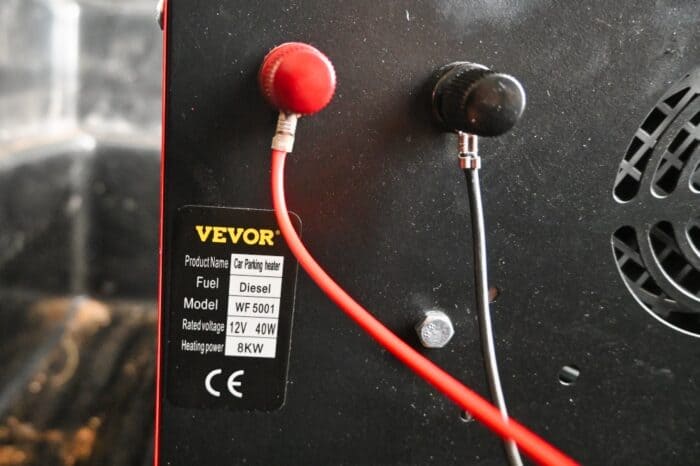
The way you install the wires on the back of the diesel heater is easy because it has terminals with bolts. Just like a battery.
Make sure you run the fuel pump program before starting it up so the pump can fill the fuel lines.
Do this by pressing the power button and the right arrow button (down button) at the same time.
Press them again to turn off the manual fill mode once the lines have been filled with diesel.
Hold the power button to start the diesel heater. You should get some heat pretty quickly.
Note that the exhaust will blow out some white smoke for about a minute and then become clear once the fuel combusts.
Always use a diesel heater outside or in a well-ventilated area with the exhaust going outside.
Optional Additions
Now, since this is a budget Chinese diesel heater, it’s missing a few parts you might want to add.
Fuel Filter
First, there’s no fuel filter, which isn’t great. A fuel filter will keep your diesel heater running better for longer.
It’s not a hard part to get or install, so it’s not a must have when you’re searching for a good diesel heater.
I used a metal fuel filter that’s made for diesel heaters.
I initially bought the smallest one I could find at my local auto parts store, but even that one wasn’t small enough for the fuel tubes.
A fuel filter needs to be installed before the fuel pump.
You can read more about installing the fuel filter into the Vevor diesel heater in this article here
Exhaust Wrap
The exhaust pipe gets extremely hot. It can be a little dangerous and even start fires if placed near dry grass.
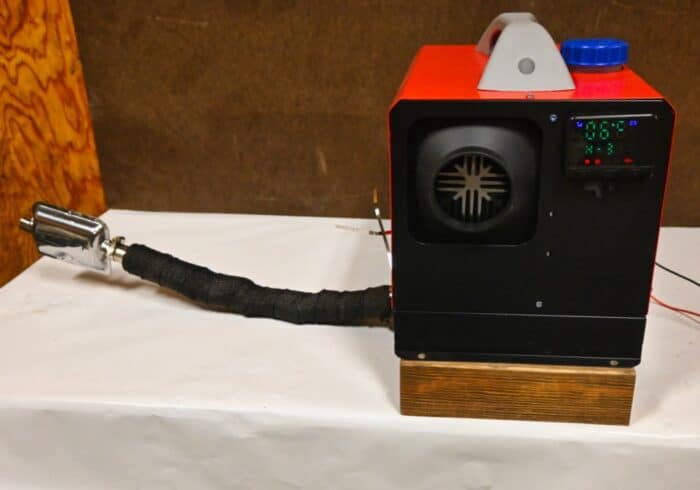
Using fiberglass exhaust wrap, you can insulate the pipe.
Make sure you use gloves when wrapping the pipe because it is made with fiberglass.
Mesh Air Intake Filter
Some Chinese diesel heaters come with a mesh air intake filter, and some don’t. My 8KW Vevor did not come with a mesh filter.
Instead, it came with a plastic tube with holes in it. Sometimes that plastic housing can have a mesh filter inside, but the Vevor didn’t.
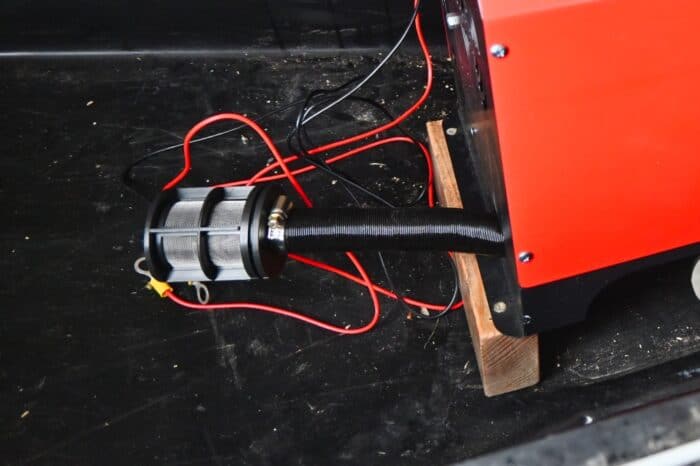
The air intake filter I bought fits perfectly on the included air intake pipe. I use it without the plastic housing so it can get plenty of air flow.
The mesh filter is important because it stops bugs from crawling inside the heater. Which can cause issues later on.
Flexible Heat Duct
The 3 inch heat duct that comes with the Vevor diesel heater isn’t very long, and it’s also not insulated.
I went to the local hardware store and picked up an 8 foot 4 inch dryer hose to make the duct long enough to go into my RV.
I later found a 3-inch 16.5-foot insulated flexible ducting that worked a lot better.
Flexible Exhaust Pipe
I needed a much longer exhaust pipe for when I put the heater in the storage compartment in my RV.
1 inch exhaust pipe can be hard to find, especially locally. I found some thicker steel flex pipe, but it was hard to clamp onto the diesel heater securely.
A 4 foot stainless steel exhaust pipe is a good option if you need a longer pipe.
Vevor Diesel Heater Testing
Heating Abilities
One thing about diesel heaters is they can put out some serious heat, and the ones sold by Vevor are no different.
There are 6 heat settings. Even when I had it put in the middle on setting 3, the air coming out was seriously hot.
I tested heating my RV on both setting 3 and 6. The temperature outside and inside my 24 foot motorhome was 32° when I started the heater.
The highest setting could heat the RV a little faster, but I’m still impressed by how well the 3 setting does.
You could easily maintain the temperature in your RV with the lower settings, even in freezing temperatures.
And this is all with just one 3 inch heat duct and vent. If there were multiple spread out it could heat even faster.
If you have a large travel trailer or 5th-wheel, connect multiple ducts to spread the heat around.
Fuel Consumption
I was a little confused by some of the information about the estimated fuel consumption of each diesel heater on Vevor’s website.
Some of the information seemed to be for the wrong size of heater. I read through it all and tried to sort the information.
As far as I could tell, Vevor estimates that its biggest diesel heater, the 8KW version, will burn anywhere from 0.1-0.48 liters of diesel an hour.
I was surprised to see that from my testing and estimating the fuel left in the tank, my values were almost exactly the same as Vevors.
When I had the heat set to 3 about 1/4 of a liter was burned in an hour. When I had the heat set to 6 about 1/2 a liter was burned in an hour.
So I think Vevor’s estimates are correct, but they are just put on the wrong sizes of heaters in some of the product information.
For those of us who use gallons instead of liters. There’s 3.8 liters in a gallon.
Using my estimates, with the Vevor diesel heater set to 6 (the highest setting), you could run the heater for at least 7 1/2 hours on one gallon of diesel.
Most of us won’t be using the highest setting once our RV is heated.
I think you could easily keep your RV warm for 24 hours with a gallon of diesel fuel.
Energy Usage
Diesel heaters have a very low electricity consumption when they’re running.
But there is an initial draw to heat the glow plugs that can pull a little more power than you might expect.
I was hoping to power my diesel heater with a portable power station using a 12 volt plug.
But unfortunately, the initial amp draw is about 11 amps.
Most power stations only have 10 amp rated 12 volt sockets. It’s so close to working, but the power station shuts itself off before the heater can start.
I think you can power smaller diesel heaters with power stations, but the large 8KW versions require at least a 15 amp 12 volt outlet if you want to use a 12 volt accessory plug.
To get by the initial power surge problem, I connected the wires directly to a 12 volt battery.
11 amps is low enough for most 12 volt batteries to handle. So you shouldn’t have any issues with a direct connection.
I tested my 12 volt AGM battery and my 12 volt Lithium-ion battery, both worked perfectly.
See Also: Best Deep Cycle RV Battery (AGM, SLA, 12V, 6V)
During the start cycle, the electricity draw will slowly increase as the glow plug heats.
The startup process takes around 2 minutes. It slowly increases the power draw until it gets to about 130 watts and then stays there for about 30 seconds.
So it has a higher initial power surge, but it’s only for 2 minutes.
When turned to the highest setting (H-6) it was using around 31 watts to run.
It bounced around a little, but that was the average.
After starting and running for an hour on high, the 8KW diesel heater used 32 watt hours.
For the next test, I had it on the middle setting (H-3). The start cycle used the same amount of power, but the standard running only used an average of 20 watts.
When turned down to the absolute lowest setting, the diesel heater drew only 10 watts.
There’s a shutdown cycle you should always let the heater go through before disconnecting it from power.
It will jump up to about 100 watts for 30 seconds, then go back down to 10 watts for the rest of the cycle.
The off cycle takes about 4 minutes. This cycle is cleaning the inside of the diesel heater.
It’s an important step that will keep your heater working for longer.
Make sure you leave enough power for this cycle to happen, otherwise soot will build up inside the heater and it might not start the next time.
You cannot turn the heater back on until the off cycle is complete.
When connected to power with the heater off, it draws around 0.2 watts for the LCD screen.
One interesting thing I noticed while using it on a much colder day when it was only 23°F outside instead of 32°F is that it used a little more electricity when running.
On the highest setting, it was drawing around 36 watts instead of just 31.
The start cycle was about the same, but for some reason, the fuel pump was using more power.
I was happy it could start in colder temperatures and the elevation here is about 5,000 feet.
After my testing, I’ve found that the Vevor 8KW portable diesel heater doesn’t use very much electricity and is perfect for boondockers or those with solar panel setups and battery banks.
Energy Usage Summary Chart
| Start Cycle | High (H-6) | Medium (H-3) | Low (H-1) | Shutdown | |
| watts | up to 130 | 31 | 20 | 10 | up to 100 watts |
| amps | 11 | 2.5 | 1.7 | 0.8 | 8.3 |
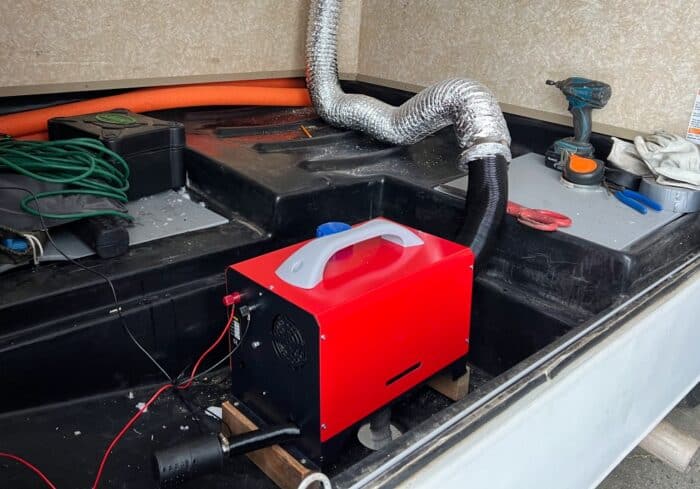
Vevor Diesel Heater Review
I’d read a lot about Chinese diesel heaters before I got the Vevor 8kw heater.
So I knew a little of what to expect, but just to say it up front, overall I’ve been very happy with this diesel heater.
It works as it should, was easy to set up as a portable unit, and compared to an RV furnace it’s very quiet.
The sound of the fuel pump clicking is what most people complain about. The higher end diesel heaters use a fuel pump that’s a little quieter.
I honestly don’t think it’s that bad, especially when compared to an RV furnace. And the pump doesn’t run all the time.
Sometimes it turns off and the only sound is the air coming out of the heater.
You can replace the factory installed fuel pump with one that is quieter. Just make sure you get the right size for your specific diesel heater.
What I Like
I love the budget friendly aspect and the diesel heater coming as a single unit.
The versions that need to be installed with all the parts in the correct positions and tapping into a vehicle’s fuel tank are too complicated for me and my limited knowledge about fuel lines and pumps.
I like the remote control a lot. I’ve read some reviews where people have said that the remote doesn’t work, but so far it’s worked great for me.
I’ve even used it to control the Vevor diesel heater from inside my motorhome. So it works through RV walls.
The low electrical usage is fantastic and the biggest reason I wanted to get a diesel heater.
What I Don’t Like
I don’t like having to mess around with the exhaust pipe so much.
It’s a pain and I wish there was an easier solution. But it’s an issue that’s not specific to just Vevor diesel heaters.
All diesel heaters need to have the exhaust pipe installed in the bottom to get the exhaust away from the heater’s air intake.
I like that they thought to add a fuse, but I don’t like that it’s inside the unit.
If it ever blows, I’m going to have to take off the cover and remove the fuel tank to access and replace it.
I wish they had placed it on the positive wire outside the unit instead.
I don’t like that it doesn’t come with a fuel filter either. It’s easy to install one, but it’s an extra addition you have to do yourself.
It’s impossible to find a fuel filter small enough in stores too. So it has to be ordered online.
Pros & Cons
PROS
- Budget Friendly
- Low Power Usage
- Low Fuel Usage
- Portable
- Powerful Heating Ability
- Remote Works Through RV Walls
- Way Quieter than RV Furnace
- Inline Fuse
CONS
- Requires Some Setting Up
- Only Shows Temp in Celsius
- No Fuel Filter
- Needs Feet Added to Fit Exhaust Pipe
- Bad Instructions
- Hard to Adjust Settings
- Can Hear Fuel Pump Clicking
Overall Impression
I have likes and dislikes with pretty much everything I use.
The cons and dislikes I’ve found with the Vevor all-in-one diesel heater aren’t deal breakers.
In fact, I actually really like the unit and think it’s very much worth what you pay for.
I would recommend this diesel heater to anyone.
With a few simple additions, it’s a fantastic diesel heater and a fantastic choice for anyone looking for a good low-power heating option.
See Also: Best 12 Volt RV Lithium Battery Reviews + How To Charge
Vevor Diesel Heater Update
Since reviewing the 8kw Vevor diesel heater, they’ve released an updated version (click to see on Vevor.com) with a few changes.
You can still get the original version I tested and reviewed, but the updated version has some new features you might want.
First, the buttons on the LCD screen have been updated. There are now 4 instead of 3, and the display shows information differently.
The remote has been changed a little as well. It looks more modern, but the buttons are the same.
Vevor has now released an app you can use to control the new 8kw diesel heater.
It connects via Bluetooth and it’s a great way to change the settings on the heater and monitor it.
It’s way easier to understand than the small LCD screen on the unit, and you can use it to turn the heater on/off.
I really like the new updates.
If it were me, I would get the new Vevor 8kw all-in-one diesel heater (click to see on Vevor.com) instead of the old version.
Have questions about Vevor Diesel Heaters? Leave a comment below.


There is no 8Kw only 2 and 5. They use false advertising to acquire more $$$. This has been PROVEN on video. The 22mm pump will produce the 5Kw. When tested with a large 65mm pump, the units managed approx 6.5Kw output, however its near the overheat shutoff protection temp.
I ordered one of the 8kw box/cube style Vevor units. When it arrived, the clear green fuel line tube wasn’t connected at either end. The end that connects on the bottom next to the air intake I could see wasn’t on the nipple. That made me concerned so I took the unit apart and sure enough, the other end wasn’t connected to the nipple coming from the pump. If I had powered this thing up it would have sprayed diesel fuel all over the place, maybe started a fire. I returned it to Amazon the next day.
Hi Jon,
That is one of the major downsides to Chinese diesel heaters. They aren’t always put together as well as they should be.
That’s why I opened up mine and inspected it before starting it like you did. It’s definitionally a major downside to these cheaper diesel heater options.
thank you for the review! I always try to research as much as possible before purchase of items that people consider ” cheap Chinese knockoffs” .
your mention of checking the internals is a great tip !
I thought they made a bigger one , and it was 110 volts ? Never got a answer
Hey Robert,
I don’t think Vevor makes a 110 volt diesel heater.
So how much “battery” would it go through to say run it for 8 hours? use a regular car battery or maybe one of those deep cell marine battery or whatever they are called? I am thinking of the 2kw unit for my 1995 GMC high top van…am thinking that should keep that smaller place nice and warm.. also… am thinking of installing it on the cargo carrier back of van in waterproof box…running the exhaust won’t be a problem… just wondering about how in the heck I would run the heater vent into the van? suppose I could keep it totally portable and when using it just set it and the battery outside by a window and use a window vent to the heating tube? Lot of questions I know…thanks for asking them if you have the time… (after reading all your information in this article I will be using the all-in-one heater and try to figure out install on rack and also heat vent?? )
Hi Victor,
It shouldn’t use more than 300 watts in 8 hours, even if you have it on high the entire time.
A regular car battery doesn’t have nearly as much storage capacity as a deep cycle battery that’s made for storing power.
So you won’t be able to run the heater for as long. But a good car battery should be able to power this diesel for at least 8 hours and still be around 50% charged.
I also struggled finding a way to get a heat vent into my RV. I ended up drilling a hole and installing a vent through the storage compartment. It could be similar to what you want to do.
Here’s a link to that article.